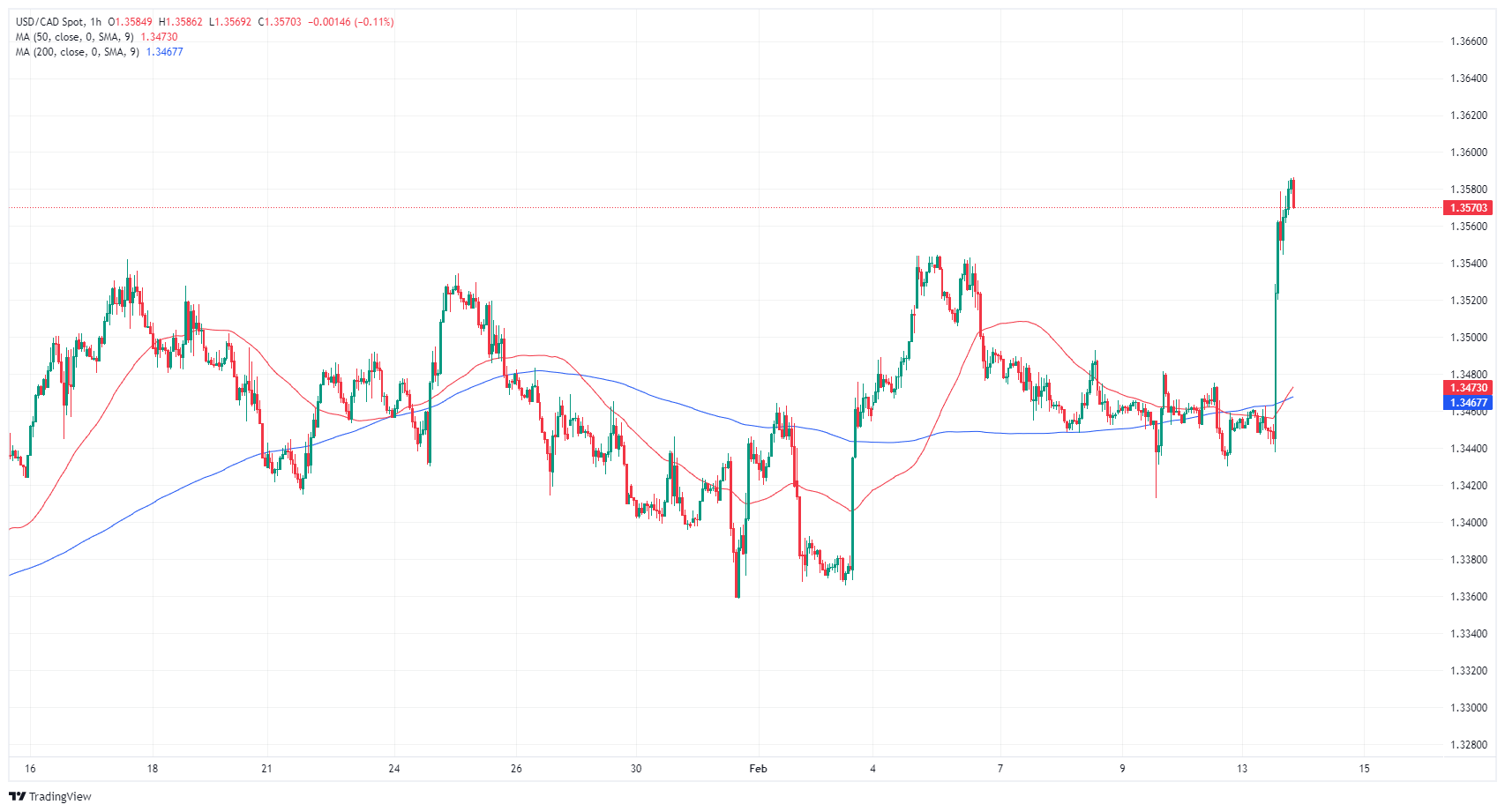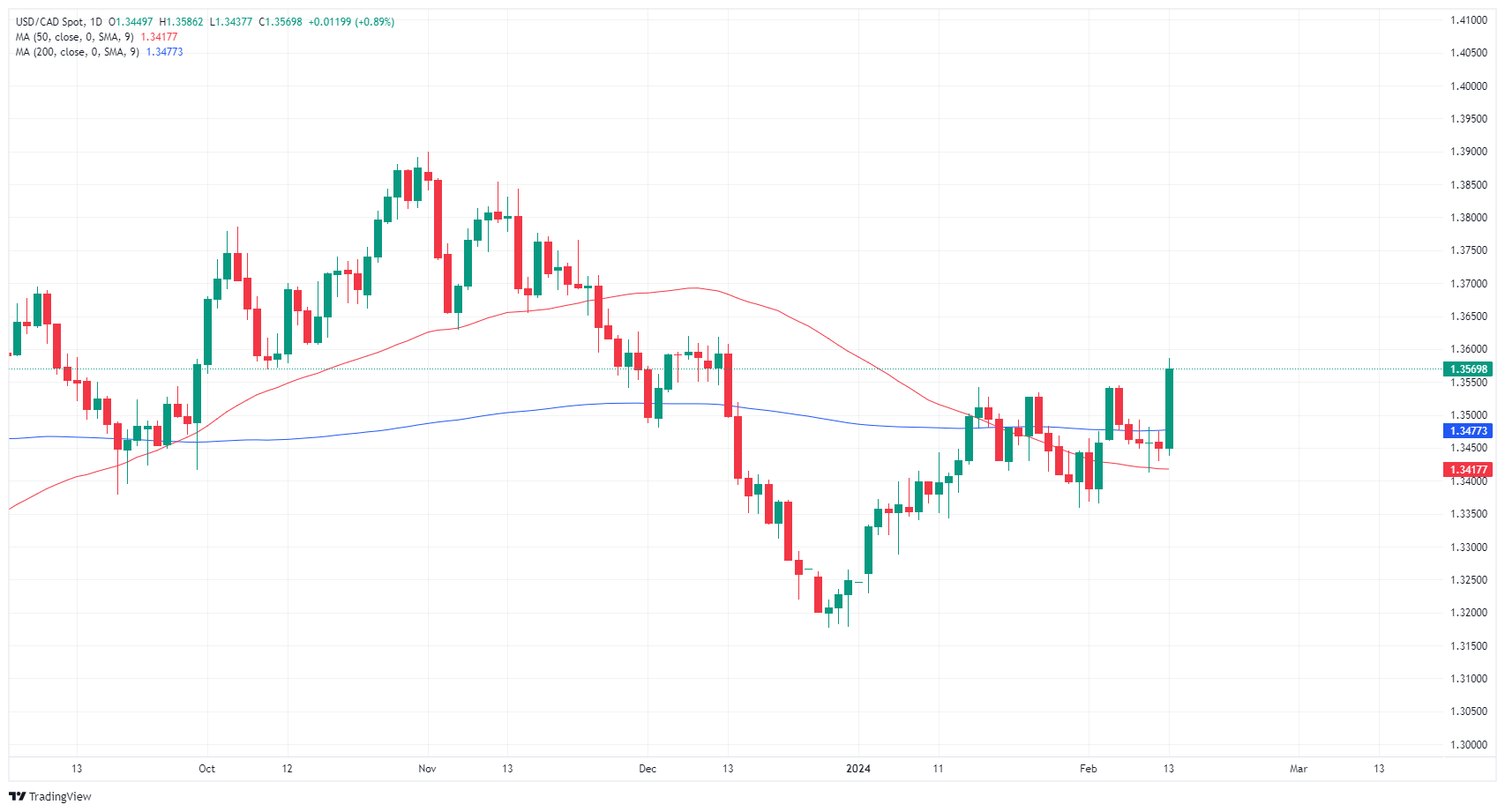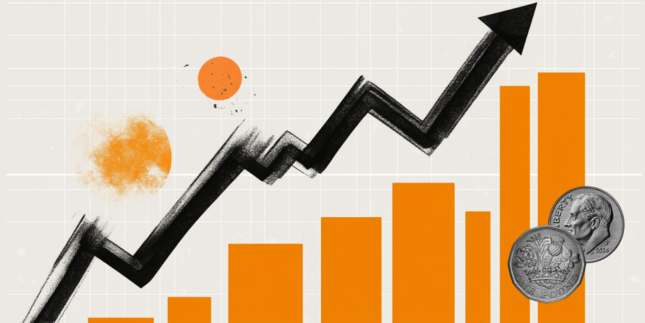Most recent article: Canadian Dollar cycles on Wednesday as markets focus elsewhere
- Markets were caught by unexpectedly stubborn US CPI inflation on Tuesday.
- Canada sees notable lack of representation on the economic calendar this week.
- Canadian Dollar is mixed on the day, but sharply lower against the US Dollar.
The Canadian Dollar (CAD) tumbled against the US Dollar (USD) on Tuesday after US Consumer Price Index (CPI) inflation ticked higher on a monthly basis, sending the Greenback surging across the major currency board. Inflation on an annual basis was also higher than consensus in January, pushing out market hopes of a May rate cut from the Federal Reserve (Fed).
Canada has only a thin showing on the economic calendar this week, and it is relegated to strictly low-tier releases. These include Canadian Housing Starts and Manufacturing Sales on Thursday and Foreign Investment figures on Friday. Canadian January Housing Starts are expected to tick upward slightly, but US Retail Sales will entirely overshadow the release.
Daily digest market movers: Canadian Dollar takes a backseat as markets focus on US CPI inflation
- Headline MoM US CPI inflation ticked higher in January to 0.3% versus the expected 0.2%.
- December’s CPI saw a slight revision from 0.3% to 0.2%.
- Core annualized US CPI inflation held steady at 3.9% compared to the forecast of 3.7%.
- YoY US CPI fell to 3.1% from 3.4%, but markets were hoping for a further deceleration to 2.9%.
- Still sticky US CPI inflation pushes out market bets of a first Fed rate cut to June or July.
- Money markets now see a 62% chance of no rate cut in May, according to the CME FedWatch Tool.
- The US Dollar is surging on the day as markets tumble back into the safe haven currency.
- Wednesday sees talking points from Fed officials, including Goolsbee and Barr.
- Thursday brings US Retail Sales, where markets are hoping for a -0.1% print for January compared to December’s 0.6%.
- Friday will wrap up a US-data-heavy week with US Producer Price Index (PPI) figures and the Michigan Consumer Sentiment Index.
Canadian Dollar price today
The table below shows the percentage change of Canadian Dollar (CAD) against listed major currencies today. Canadian Dollar was the strongest against the Swiss Franc.
| USD | EUR | GBP | CAD | AUD | JPY | NZD | CHF | |
| USD | 0.58% | 0.30% | 0.85% | 1.18% | 0.91% | 1.14% | 1.30% | |
| EUR | -0.59% | -0.29% | 0.28% | 0.60% | 0.32% | 0.55% | 0.72% | |
| GBP | -0.29% | 0.30% | 0.57% | 0.90% | 0.62% | 0.85% | 1.01% | |
| CAD | -0.87% | -0.28% | -0.56% | 0.31% | 0.05% | 0.28% | 0.44% | |
| AUD | -1.20% | -0.62% | -0.92% | -0.33% | -0.29% | -0.05% | 0.15% | |
| JPY | -0.91% | -0.31% | -0.61% | -0.06% | 0.26% | 0.24% | 0.38% | |
| NZD | -1.15% | -0.56% | -0.85% | -0.29% | 0.04% | -0.23% | 0.16% | |
| CHF | -1.30% | -0.71% | -1.01% | -0.44% | -0.14% | -0.39% | -0.15% |
The heat map shows percentage changes of major currencies against each other. The base currency is picked from the left column, while the quote currency is picked from the top row. For example, if you pick the Euro from the left column and move along the horizontal line to the Japanese Yen, the percentage change displayed in the box will represent EUR (base)/JPY (quote).
Technical analysis: Canadian Dollar gives up ground to surging US Dollar but trades mixed overall
The Canadian Dollar (CAD) slipped around three-quarters of a percent against the US Dollar on Tuesday, also losing around half of a percent against the Pound Sterling (GBP). The CAD recovered half a percent against the Swiss Franc (CHF) and around a third of a percent against the New Zealand Dollar (NZD).
The USD/CAD surged to an eight-week high on Tuesday, hitting a near-term high of 1.3578. The pair surged over a full percent bottom-to-top on the day, easily reclaiming the 1.3500 handle.
Tuesday’s bull run in the USD/CAD has the pair breaking into the top side of the 200-day Simple Moving Average (SMA) near 1.3477, and the trick for buyers will be to keep the pair from slumping back into a rough consolidation range below 1.3550. On the bottom end, the 50-day SMA near 1.3417 will provide a near-term technical floor.
USD/CAD hourly chart
USD/CAD daily chart
Canadian Dollar FAQs
What key factors drive the Canadian Dollar?
The key factors driving the Canadian Dollar (CAD) are the level of interest rates set by the Bank of Canada (BoC), the price of Oil, Canada’s largest export, the health of its economy, inflation and the Trade Balance, which is the difference between the value of Canada’s exports versus its imports. Other factors include market sentiment – whether investors are taking on more risky assets (risk-on) or seeking safe-havens (risk-off) – with risk-on being CAD-positive. As its largest trading partner, the health of the US economy is also a key factor influencing the Canadian Dollar.
How do the decisions of the Bank of Canada impact the Canadian Dollar?
The Bank of Canada (BoC) has a significant influence on the Canadian Dollar by setting the level of interest rates that banks can lend to one another. This influences the level of interest rates for everyone. The main goal of the BoC is to maintain inflation at 1-3% by adjusting interest rates up or down. Relatively higher interest rates tend to be positive for the CAD. The Bank of Canada can also use quantitative easing and tightening to influence credit conditions, with the former CAD-negative and the latter CAD-positive.
How does the price of Oil impact the Canadian Dollar?
The price of Oil is a key factor impacting the value of the Canadian Dollar. Petroleum is Canada’s biggest export, so Oil price tends to have an immediate impact on the CAD value. Generally, if Oil price rises CAD also goes up, as aggregate demand for the currency increases. The opposite is the case if the price of Oil falls. Higher Oil prices also tend to result in a greater likelihood of a positive Trade Balance, which is also supportive of the CAD.
How does inflation data impact the value of the Canadian Dollar?
While inflation had always traditionally been thought of as a negative factor for a currency since it lowers the value of money, the opposite has actually been the case in modern times with the relaxation of cross-border capital controls. Higher inflation tends to lead central banks to put up interest rates which attracts more capital inflows from global investors seeking a lucrative place to keep their money. This increases demand for the local currency, which in Canada’s case is the Canadian Dollar.
How does economic data influence the value of the Canadian Dollar?
Macroeconomic data releases gauge the health of the economy and can have an impact on the Canadian Dollar. Indicators such as GDP, Manufacturing and Services PMIs, employment, and consumer sentiment surveys can all influence the direction of the CAD. A strong economy is good for the Canadian Dollar. Not only does it attract more foreign investment but it may encourage the Bank of Canada to put up interest rates, leading to a stronger currency. If economic data is weak, however, the CAD is likely to fall.
Information on these pages contains forward-looking statements that involve risks and uncertainties. Markets and instruments profiled on this page are for informational purposes only and should not in any way come across as a recommendation to buy or sell in these assets. You should do your own thorough research before making any investment decisions. FXStreet does not in any way guarantee that this information is free from mistakes, errors, or material misstatements. It also does not guarantee that this information is of a timely nature. Investing in Open Markets involves a great deal of risk, including the loss of all or a portion of your investment, as well as emotional distress. All risks, losses and costs associated with investing, including total loss of principal, are your responsibility. The views and opinions expressed in this article are those of the authors and do not necessarily reflect the official policy or position of FXStreet nor its advertisers. The author will not be held responsible for information that is found at the end of links posted on this page.
If not otherwise explicitly mentioned in the body of the article, at the time of writing, the author has no position in any stock mentioned in this article and no business relationship with any company mentioned. The author has not received compensation for writing this article, other than from FXStreet.
FXStreet and the author do not provide personalized recommendations. The author makes no representations as to the accuracy, completeness, or suitability of this information. FXStreet and the author will not be liable for any errors, omissions or any losses, injuries or damages arising from this information and its display or use. Errors and omissions excepted.
The author and FXStreet are not registered investment advisors and nothing in this article is intended to be investment advice.
Recommended content
Editors’ Picks

EUR/USD retreats below 1.0800 ahead of US data
EUR/USD loses traction and trades below 1.0800 on Tuesday. The risk-averse market atmosphere ahead of Wednesday's tariff announcements makes it difficult for the pair to hold its ground as the market attention turns to US data releases.

GBP/USD struggles to stabilize above 1.2900
Following a short-lasting uptick in the European session, GBP/USD edges lower and trades slightly below 1.2900 on Tuesday. The US Dollar (USD) holds its ground as investors adopt a cautious stance in anticipation of data releases and Wednesday's tariff decisions.

Gold pulls away from record highs, holds comfortably above $3,100
Gold corrects lower but manages to hold comfortably above $3,100 after touching a new record-high near $3,150 earlier in the day. Falling US Treasury bond yields help XAU/USD limit its losses as investors refrain from taking large positions ahead of US tariff announcements.

JOLTS job openings set to decline modestly in February
The Job Openings and Labor Turnover Survey (JOLTS) will be released on Tuesday by the United States Bureau of Labor Statistics. Markets expect job openings to decline to 7.63 million on the last business day of February.

Is the US economy headed for a recession?
Leading economists say a recession is more likely than originally expected. With new tariffs set to be launched on April 2, investors and economists are growing more concerned about an economic slowdown or recession.

The Best brokers to trade EUR/USD
SPONSORED Discover the top brokers for trading EUR/USD in 2025. Our list features brokers with competitive spreads, fast execution, and powerful platforms. Whether you're a beginner or an expert, find the right partner to navigate the dynamic Forex market.

